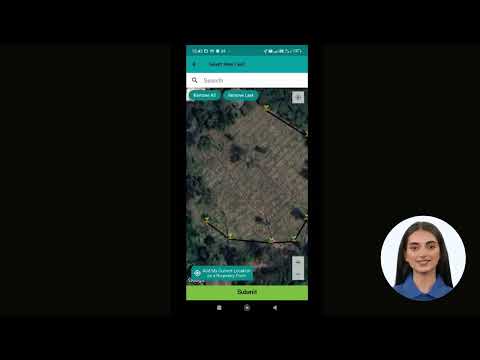10 Cost-Effective Farming Strategies for Ontario Growers: Optimize Inputs and Boost Yields
“Ontario farmers can reduce seed costs by up to 15% by optimizing planting rates without sacrificing yield potential.”
Welcome, Ontario growers! In today’s challenging agricultural landscape, we understand the pressing need to maximize yields while minimizing costs. As your trusted partners in precision agriculture, we at Farmonaut are committed to helping you achieve these goals through innovative technologies and data-driven insights. In this comprehensive guide, we’ll explore ten cost-effective farming strategies tailored specifically for Ontario’s unique growing conditions. These strategies will help you optimize your inputs, boost your yields, and ultimately, increase your farm’s profitability.
Before we dive into the strategies, let’s take a moment to consider the power of technology in modern farming. At Farmonaut, we leverage cutting-edge satellite imagery and artificial intelligence to provide real-time crop health monitoring and personalized farm advisory services. Our platform is designed to make precision agriculture accessible and affordable for farmers of all scales.
Now, let’s explore the ten cost-effective farming strategies that can revolutionize your Ontario farm:
1. Optimize Seed Planting Rates
One of the most straightforward ways to reduce input costs without sacrificing yield potential is by optimizing your seed planting rates. Many Ontario growers tend to overplant, believing that more seeds equal higher yields. However, this approach can lead to unnecessary expenses and potentially reduced yields due to overcrowding.
- Conduct field-specific assessments to determine optimal planting rates
- Consider factors such as soil type, fertility, and historical yield data
- Use precision planting equipment to ensure accurate seed placement
- Monitor and adjust rates based on performance data from previous seasons
By fine-tuning your planting rates, you can significantly reduce seed costs while maintaining or even improving yields. This strategy is particularly effective for crops like soybeans and corn, which are staples in Ontario agriculture.
2. Implement Soil Testing for Fertilizer Efficiency
Efficient fertilizer use is crucial for both cost reduction and environmental stewardship. Regular soil testing allows you to apply the right amount of nutrients where they’re needed most, avoiding over-application and potential runoff issues.
- Conduct comprehensive soil tests at least every 2-3 years
- Focus on key nutrients like nitrogen, phosphorus, and potassium
- Use grid sampling or zone management for more precise applications
- Consider tissue testing during the growing season for fine-tuning
By implementing a robust soil testing program, you can optimize your fertilizer use, reduce input costs, and ensure your crops receive the nutrients they need for optimal growth.
3. Adopt Modern Herbicide Application Techniques
Weed control is a significant expense for Ontario growers, but modern application techniques can help reduce herbicide use without compromising effectiveness. By leveraging technology and best practices, you can achieve better weed control while lowering your input costs.
- Utilize precision spraying equipment with GPS guidance
- Implement variable rate applications based on weed pressure maps
- Consider using pre-emergence herbicides for longer-lasting control
- Rotate herbicide modes of action to prevent resistance development
These techniques not only reduce your herbicide costs but also minimize environmental impact and help preserve the long-term efficacy of these important tools.
4. Explore Equipment Sharing Opportunities
Farm equipment represents a significant capital investment for Ontario growers. By exploring equipment sharing opportunities with neighboring farms, you can reduce your overhead costs without sacrificing access to essential machinery.
- Identify complementary equipment needs with nearby growers
- Establish clear agreements on usage, maintenance, and scheduling
- Consider forming or joining a local equipment co-op
- Explore leasing options for specialized or infrequently used equipment
Equipment sharing not only reduces your capital expenditures but also allows you to access a wider range of machinery than you might be able to afford individually.
5. Implement Strategic Crop Rotation
“Implementing crop rotation strategies can increase soil fertility and crop yields by 10-20% while reducing fertilizer needs.”
Crop rotation is a time-tested strategy that offers numerous benefits for Ontario growers. By carefully planning your rotation, you can improve soil health, break pest and disease cycles, and potentially reduce your reliance on inputs.
- Rotate between crops with different nutrient needs and rooting depths
- Include nitrogen-fixing legumes like soybeans in your rotation
- Consider cover crops to improve soil structure and organic matter
- Plan rotations that disrupt pest life cycles specific to Ontario
A well-designed crop rotation can lead to improved yields, reduced input costs, and long-term soil health benefits.
6. Leverage Precision Agriculture Technologies
Precision agriculture technologies, like those offered by Farmonaut, can significantly improve your farm’s efficiency and profitability. By leveraging satellite imagery, AI-driven insights, and advanced analytics, you can make more informed decisions about your farm management practices.
- Use satellite-based crop health monitoring to identify issues early
- Implement variable rate applications for seeds, fertilizers, and pesticides
- Utilize weather data and forecasts to optimize planting and harvesting times
- Track and analyze field-level data to identify areas for improvement
Farmonaut’s platform provides these capabilities and more, helping Ontario growers optimize their operations and reduce input costs.
Explore Farmonaut’s precision agriculture solutions:
7. Optimize Irrigation Practices
While Ontario generally receives ample rainfall, efficient irrigation management can still play a crucial role in optimizing yields and reducing water-related costs. By implementing smart irrigation practices, you can ensure your crops receive the right amount of water at the right time.
- Use soil moisture sensors to guide irrigation decisions
- Implement drip irrigation systems for water-intensive crops
- Consider deficit irrigation strategies for drought-tolerant crops
- Utilize weather data and evapotranspiration models to schedule irrigation
Optimizing your irrigation practices not only reduces water usage but can also lead to improved crop quality and yields.
8. Implement Integrated Pest Management (IPM)
Integrated Pest Management (IPM) is a holistic approach to pest control that can significantly reduce your reliance on chemical pesticides. By combining various control methods and monitoring pest populations closely, you can achieve effective pest management while minimizing input costs.
- Regularly scout fields for pest presence and damage
- Use economic thresholds to determine when treatment is necessary
- Incorporate biological control methods, such as beneficial insects
- Rotate pesticide modes of action to prevent resistance development
IPM not only reduces your pesticide costs but also promotes a healthier farm ecosystem and can lead to improved crop quality.
9. Optimize Nutrient Management
Efficient nutrient management is crucial for maximizing yields while minimizing input costs. By carefully matching nutrient applications to crop needs and soil conditions, you can reduce fertilizer waste and improve your overall farm profitability.
- Use split applications to improve nutrient uptake efficiency
- Consider slow-release fertilizer formulations for extended nutrient availability
- Implement precision application techniques, such as banding or injection
- Monitor crop nutrient status throughout the growing season for fine-tuning
Optimizing your nutrient management strategy can lead to significant cost savings while maintaining or even improving crop yields.
10. Embrace Conservation Tillage Practices
Conservation tillage practices, such as no-till or reduced tillage, can offer numerous benefits for Ontario growers. These practices can help reduce fuel and labor costs, improve soil health, and increase water retention.
- Gradually transition to reduced tillage or no-till systems
- Use cover crops to manage residue and improve soil structure
- Invest in appropriate equipment for conservation tillage systems
- Monitor and adjust nutrient management practices for no-till conditions
By embracing conservation tillage practices, you can reduce your input costs while promoting long-term soil health and sustainability.
Implementing These Strategies with Farmonaut
At Farmonaut, we’re committed to helping Ontario growers implement these cost-effective farming strategies through our advanced satellite-based farm management solutions. Our platform provides valuable insights into crop health, weather patterns, and field conditions, enabling you to make data-driven decisions that optimize your inputs and boost your yields.
Key features of Farmonaut’s platform include:
- Real-time crop health monitoring using satellite imagery
- AI-powered advisory system for personalized farm management recommendations
- Weather forecasting and historical data analysis
- Field-level performance tracking and yield estimation
By leveraging these tools, you can take your farm’s efficiency and profitability to the next level. Our goal is to make precision agriculture accessible and affordable for all Ontario growers, regardless of farm size or technical expertise.
Cost-Benefit Analysis of Farming Strategies
To help you better understand the potential impact of these strategies on your farm, we’ve prepared a cost-benefit analysis table. This table provides estimates of cost reduction, yield increase, implementation difficulty, and long-term benefits for each strategy.
| Strategy | Estimated Cost Reduction (%) | Potential Yield Increase (%) | Implementation Difficulty (1-5 scale) | Long-term Benefits |
|---|---|---|---|---|
| Optimized Seed Planting Rates | 10-15% | 0-5% | 2 | Improved plant spacing, reduced competition |
| Soil Testing for Fertilizer Efficiency | 15-20% | 5-10% | 3 | Enhanced soil health, reduced environmental impact |
| Modern Herbicide Application Techniques | 20-30% | 5-15% | 4 | Reduced weed pressure, improved crop quality |
| Equipment Sharing | 25-40% | N/A | 3 | Reduced capital costs, access to diverse equipment |
| Crop Rotation | 10-20% | 10-20% | 3 | Improved soil health, reduced pest pressure |
This table provides a quick overview of the potential benefits and challenges associated with each strategy. Keep in mind that actual results may vary depending on your specific farm conditions and implementation approach.
Getting Started with Farmonaut
Ready to take your Ontario farm to the next level with cost-effective, data-driven strategies? Farmonaut offers a range of subscription options to suit farms of all sizes. Our platform is accessible via web browser, Android, and iOS apps, making it easy to monitor your fields and access valuable insights from anywhere.
To get started with Farmonaut:
- Visit our website or download our mobile app
- Create an account and select your subscription plan
- Map your fields using our intuitive interface
- Start receiving real-time insights and recommendations
For those interested in integrating Farmonaut’s data into their existing systems, we also offer API access. Learn more about our API capabilities here: Farmonaut API
Detailed documentation for developers is available at: API Developer Docs
Conclusion
Implementing cost-effective farming strategies is crucial for the success and sustainability of Ontario farms. By leveraging precision agriculture technologies and data-driven insights, you can optimize your inputs, boost your yields, and improve your overall farm profitability.
At Farmonaut, we’re committed to supporting Ontario growers with cutting-edge satellite-based farm management solutions. Our platform empowers you to make informed decisions, reduce waste, and maximize the potential of your fields. By combining these innovative technologies with the tried-and-true strategies outlined in this guide, you can position your farm for long-term success in an ever-changing agricultural landscape.
Remember, sustainable and profitable farming is a journey of continuous improvement. Start implementing these strategies today, and don’t hesitate to reach out to our team at Farmonaut for personalized support and guidance. Together, we can build a more resilient and prosperous future for Ontario agriculture.
Frequently Asked Questions (FAQ)
Q1: How can Farmonaut help me implement these cost-effective farming strategies?
A1: Farmonaut provides real-time satellite imagery and AI-driven insights to help you monitor crop health, optimize input use, and make data-driven decisions. Our platform supports strategies like precision planting, efficient fertilizer use, and targeted pest management.
Q2: Is Farmonaut suitable for small-scale Ontario farmers?
A2: Absolutely! Farmonaut is designed to be accessible and affordable for farms of all sizes. We offer flexible subscription plans to meet the needs of small, medium, and large-scale operations.
Q3: How often is satellite data updated on Farmonaut’s platform?
A3: Our satellite data is typically updated every 3-5 days, depending on weather conditions and satellite availability. This frequent update cycle ensures you have access to timely information for making critical farm management decisions.
Q4: Can Farmonaut help me with crop-specific management strategies?
A4: Yes, Farmonaut’s AI advisory system provides personalized recommendations based on your specific crops, field conditions, and local weather patterns. This includes guidance on planting dates, irrigation scheduling, and pest management for various crops common in Ontario.
Q5: How does Farmonaut’s technology integrate with my existing farm equipment?
A5: While Farmonaut doesn’t directly control farm equipment, our platform can provide valuable data and insights that can be used to guide your equipment operations. For more advanced integration, we offer API access that can potentially be used to connect with compatible smart farming equipment.








